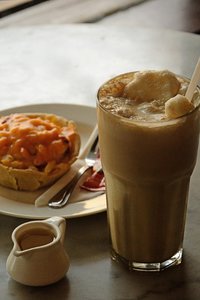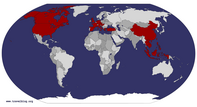Advertisement
Published: September 10th 2013

 Caffeine Kick for Breakfast
Caffeine Kick for Breakfast
Iced espresso and baked mac and cheese pie at Bakoel KoffieI am inside a coffee house in central Jakarta, nibbling on baked macaroni and cheese pie and sipping iced espresso. Strangely, a feeling of calmness greets me. A pleasant day has just begun, and though all forms of transport are hurtling through the streets of Indonesia’s notorious capital, it’s not as assaulting as I have been led to believe. It seems like only a few vendors and other early risers own the streets. Granted, it’s a Sunday morning and – I don’t know it yet – people are just gathering energy for the spurt of activities later in the day.
Sleeplessness led me out early from the Six Degrees Backpackers’ Hostel just a few meters down the street. I decided to start my exploration of Jakarta in Cikini, a small neighborhood southeast of the central Gambir train station, and an area known for its coffee and arts culture. I ambled past crumbling buildings with the paint peeling off, past roadside food vendors talking to each other in Bahasa, past walls decorated with interesting murals from vandalizing youths, and past rows of coffee shops.
Jakarta is popular for its disorder and danger. It’s the epitome of a megapolis hurtling through

 Batoel Koffie
Batoel Koffie
Cafes are dime a dozen in Jakarta. The Batoel Koffie in Cikini provides a serene setting for customers.the present in a mad dash to the future, as typified by the motorists and their blatant disregard for pedestrians. But beneath all the energy are pockets of stillness at places like Cikini, where much of the city’s artists and vanguard thinkers converge. Bakoel Koffie, where I’m now having my breakfast, is an oasis of calmness.
With mellow Indonesian songs in the background, the café’s staff are talking and laughing at each other. The smell of coffee beans hangs through the air, a marked contrast to the smell of vehicle exhaust outside. The only knock to my almost perfect setting is that the view right outside my window is of a building undergoing construction with workers and trucks bustling around the area.
Coffee shops are a hit anywhere, but few other countries make for a better coffee-drinking experience than Indonesia. Its main island Java, is synonymous with the beverage, and the whole archipelago is the third largest coffee-producing country in the world. Arabica coffee beans were first introduced by the Dutch East India Company in the archipelago in the 17
th century, with the first coffee plantations developed initially in the regions surrounding Batavia (now Jakarta). And when the

 Taman Fatahillah
Taman Fatahillah
Crowds flock at the Fatahillah Square in Jakarta's old town where buskers regularly hold performances.favorable tropical conditions led to good yields, other plantations were set up across the island. Along with Sulawesi and Sumatra, Java currently ranks as one of Indonesia's major coffee producers with its most famous products, the gourmet Arabica coffee and aged coffee beans in Old Java.
Today Jakarta boasts of several coffee shops across the city, with locals joining in on the coffee craze. Cafés range from the elegant international chain types to the humble warung-style ones. Indonesians typically like their caffeine with a massive sugar kick, which leads me to wonder if this, along with the carbo-loaded nasi and noodles, is where the locals get their unbounded pep for the rest of the day.
As soon as I finish my pie and coffee, I head outside to explore the rest of the neighborhood. I start with the Taman Ismail Marzuki, what longtime Jakarta resident Andrew Whitmarsh describes as the site “where the essence of what it means to be an artist remains vividly alive.” Named after a local musician, the TIM is where Jakarta’s experimental artists strut their works, as well as a venue for traditional performances, such as
gamelan orchestras and
wayang 
 Kota
Kota
Young people use the crumbling Dutch architecture as background for their Sunday afternoon photo shoot.kulit shows.
The first building that greets me inside the compound is the planetarium, whose unremarkable features remain unchanged for more than four decades now. It’s mainly targeted at teaching local students basic astronomical concepts. Galeri Cipta II and Galeri Cipta III, two venues for artworks that push forth the envelope in a relatively conservative country, are inside the TIM as well. The Cinema XXI is where Indonesian filmmakers get to show their movies.
The street to the left of Galeri Cipta III leads to the Jakarta Insitute of Arts (Institut Kesenian Jakarta). It’s supposed to house a host of art installations in an outdoor setting but today, what’s on display is a large sign that I suppose reads “Under Renovation.” A truck rumbles past by and stops in front of the building’s gate and spits out a flood of workers who rush inside the school compound.
I backtrack to the main street again and head south to the Sekolah Menengan Pertamah, a junior high school popular mainly for two things. One, it was where all of President Sukarno’s children attended; and, two, it was the site of a failed assassination attempt on the former president on

 Cafe Batavia
Cafe Batavia
Locals spend the afternoon in front of the historic restaurant in KotaNovember 30, 1957.
I end my morning walk at the Cikini train station and drop by the flower market. A group of women are sifting through bouquets of flowers as the city slowly emerges from its extended sleep. Gradually the din and chaos of Jakarta are starting to reveal themselves. I take a quick look around, then decide to return to the hostel.
……….
In the afternoon I find myself riding Jakarta’s train from the Monas to Kota, the “old town” of Jakarta up north. In contrast to the chilled out vibe of Cikini in an early Sunday morning, the frenzy of Kota feels like a migraine. Floods of people crowd the dingy train station and outside is only marginally better; the air is polluted and the sense of dilapidation is in almost every building and powder blue
angkot (minivan).
But to truly understand Jakarta, I have to come here. This gritty enclave of the capital is the historical heart of a city that’s too eager to meet the future that the vestiges of its yesteryears are on the brink of going away for good. "It can be hard to imagine a time when Kota was

 Istqlal Mosque
Istqlal Mosque
Devotees praying at Indonesia's largest mosquenearly the entire city of Jakarta," says Whitmarsh. "That is the very reason, though, that the area is a historical goldmine."
In the 16
th century Kota was a fortified city with walls set up to keep would-be invaders out and the European colonists safe inside. At the center of the city is the Taman Fatahillah, a public square whose upbeat atmosphere now belies its background as a former place of execution. Here, in the colonial era, a number of people, mostly slaves, were killed by guillotine, sword, or other cruelly slow means. Today, it’s a place for locals and foreigners to witness buskers put on a show, to join protesters in calling out the government, or to watch young people go around the square on their rented bikes and color-matching hats.
The square itself is surrounded by historical buildings, some of which have been turned into museums, like the Museum Wayang (Shadow Puppet) and the Fine Arts and Ceramics Museum. At the north end of the park stands the Café Batavia, an historical restaurant first built in 1810, and today serves some of the finest foods in Jakarta.
I can only take so much of the place's

 Monas
Monas
Girls in cosplay costume posing in front of the Monumen Nasionalraw energy, though, so after an hour, I ride a train back to central Jakarta.
……….
Still buoyed by the overdose of caffeine earlier, and eating a plateful of tempeh from a roadside vendor just outside the Monumen Nasional (National Monument) gate, I sit on a bench overlooking the city’s iconic landmark – the 433-foot structure is erected in 1961 and publicly opened in 1975.
The Monas, with its flame tip and Italian marble body, stands on what once was a grazing land for cattle. There are no lush vegetation nowadays near the place, though the trees and grass surrounding the cobblestone pathways draw crowds and keep them lingering for hours.
This Sunday afternoon, the area is playing host to a range of activities, from street rallies to young boys flying kites. A trio of girls in cosplay costume is strolling around the area. Though my feet are hurting from the walk, I ignore the weariness and stand up to catch up with the girls. I eagerly try one of the first sentences I have learned in Bahasa Indonesia.
“
Boleh fotoh?” May I take your picture?
“
Boleh!” they say. I take a few shots

 Sweet Endings
Sweet Endings
A pair of J.Co donuts and iced coffee round out the day.of them and say my
terima kasih after.
I walk around once more. A man with a shaggy beard is doing a puppet show. A couple of men in oversized mascot costumes are playfully terrorizing some Japanese tourists. Hawkers are calling out to passers-by using whistles that sound like a wailing baby. It's all fun. In the spirit of the city, I am imbibing in the chaos of the surroundings with a genuine smile.
..........
My trip around the city was inspired by three of the walking tours in Andrew Whitmarsh's Jakarta: 25 Excursions in and around the Indonesian Capital . In particular, these walks were the Walking Tour 4: Kota and Mangga Dua; Walking Tour 6: Monas and Pasar Baru; and Walking Tour 9: Cikini.
Advertisement
Tot: 0.139s; Tpl: 0.015s; cc: 15; qc: 30; dbt: 0.0466s; 1; m:domysql w:travelblog (10.17.0.13); sld: 1;
; mem: 1.1mb


























RENanDREW
Ren & Andrew
Hi Jay, enjoyed this blog very much. Jakarta can be a difficult city to get to know, and you have captured a lovely vibe in this post.